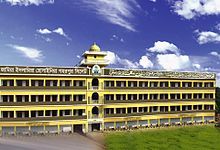Nur Uddin Gohorpuri
Nur Uddin Ahmed Gohorpuri (Bengali: নূর উদ্দিন আহমদ গহরপুরী; 1924 – 26 April 2005) was a Bengali religious scholar and teacher. He was notable for his association with Qawmi Madrasahs in Bangladesh as well as for having been the founder of Gohorpur Hussainia Madrasa.
Nur Uddin Gohorpuri | |
|---|---|
| Title | Maulana, Allamah, Shaikh-ul-Hadith |
| Personal | |
| Born | 1924 |
| Died | 26 April 2005 (aged 81) |
| Resting place | Gohorpur, Balaganj Upazila, Sylhet Division, Bangladesh |
| Religion | Islam |
| Era | Modern |
| Movement | Deobandi |
| Alma mater | Darul Uloom Deoband |
| Profession | Islamic scholar, teacher |
| Muslim leader | |
Influenced by
| |
| Profession | Islamic scholar, teacher |
Biography
Gohorpuri was born in 1924 to a aristocratic family in the village of Gohorpur, located in what is now Sylhet Division, Bangladesh. Following the death of his father, who had been a scholar, Gohorpuri was given at a young age to Bashir Uddin, a religious figure, to be trained as his disciple. He was later enrolled in Darul Uloom Deoband, where he encountered Hussain Ahmed Madani, who had been Bashir Uddin's teacher. Following his graduation in 1950, Gohorpuri became one of Madani's pupils himself.[2][3]
In 1952, upon Madani's instructions, he became employed as a hadith scholar at the Pangasia Alia Madrasa in Barisal for two years, before transferring to perform the same role at the Balia Madrasa in Mymensingh. In 1956, he returned to his native village and founded the Gohorpur Hussainia Madrasa, serving there as the hadith scholar and muhtamim (principal) for the remainder of his life.[2][3] It later became one of the most prominent Islamic educational institutions in Bangladesh.[4] During the 1960s, Gohorpuri joined the Jamiat Ulema-e-Islam political party, running unsuccessfully for the National Assembly during the 1970 Pakistani general election. He was elected chairman of Befaqul Madarisil Arabia Bangladesh in 1996, becoming associated with more than 50 Qawmi Madrasahs as well as being the founder and patron of 13.[3]

Gohorpuri died on 26 April 2005 at the age of 81. He left behind four wives, four daughters and a son, Muslehuddin Raju, the latter of whom succeeded him as head of Gohorpur Hussainia Madrasa.[2][5] His funeral in front of his home in Gohorpur was attended by several thousand of his pupils.[3]
References
- al-Mahmud, A.H.; Hasan, Syed Mahmudul (2008). সুন্নাতে নববীর মূর্ত প্রতীক: মাওলানা আব্দুল মতিন চৌধুরী শায়খে ফুলবাড়ী রাহ (in Bengali). Sylhet: al-Medina Offset Press. p. 45.CS1 maint: ref=harv (link)
- "আল্লামা নুর উদ্দিন আহমদ গহরপুরীর মৃত্যু বার্ষিকী আজ". Sylhet Report (in Bengali). 2019-04-26. Archived from the original on 2020-06-10. Retrieved 2020-06-10.
- "আল্লামা গহরপুরী পরিচিতি". গহরপুর হোসাইনিয়া মাদ্রাসা (in Bengali). Archived from the original on 2019-08-17. Retrieved 2019-08-17.
- "সিলেট গহরপুর জামিয়ার বার্ষিক মাহফিল বৃহস্পতিবার". Barta24 (in Bengali). 2018-12-18. Archived from the original on 2020-06-12. Retrieved 2020-06-12.
- "গহরপুর জামিয়ার কওমি গ্র্যাজুয়েশন থেকে সনদ নিলেন তরুণ আলেমরা". Banglanews24.com (in Bengali). 2017-02-25. Archived from the original on 2020-06-12. Retrieved 2020-06-12.